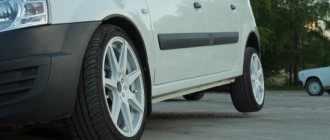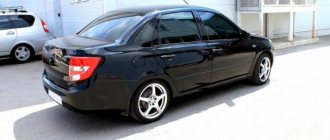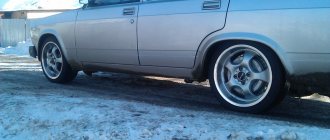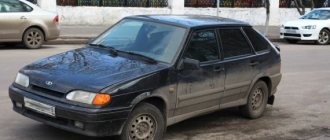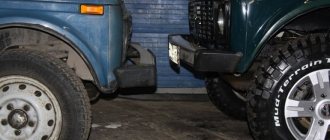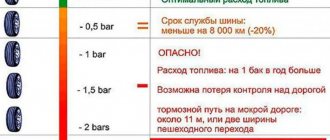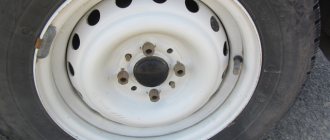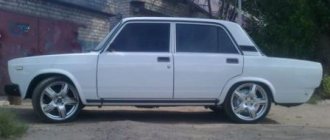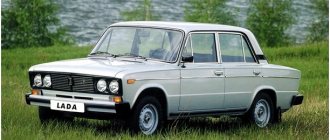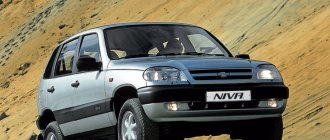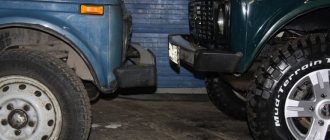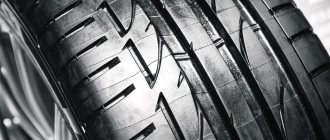Kia Rio is a city family car, classified according to the European classification as class “B”. It has a large interior and a spacious trunk, and is economical in fuel consumption, which distinguishes it very favorably from more bulky cars of class “C” and higher. Let's look at what wheel sizes can be installed on the Rio, and also give recommendations on choosing tires.
Wheel sizes of Kia Rio 4th generation
Kia Rio 2016, 4th generation Drilling - 4×100 (PCD), offset - 48 mm (ET), central hole diameter - 54.1 mm (DIA), mounting to the hub - bolt, thread - M12x1.5
| Kia Rio tire size 4 | Kia Rio 4 rim size |
| 185/65R15 | 6Jx15 |
| 195/55R16 | 6Jx16 |
What does the manufacturer recommend?
The factory tire size for the first generation is tires with the following parameters: width - 175 mm, profile height - 70% of the width (or 122.5 mm), wheel radius - 13 inches (hereinafter we will indicate the standard size in the classic form, that is, 175/ 70R13). The load index per tire is 82 (no more than 475 kg per wheel), and the speed is T (no more than 190 km/h).
- KIA Rio II was produced with wheels of size 175/70R14. Load index 84 (500 kg), speed – T.
- The third generation of Rio has stepped forward in many ways compared to its predecessors. One of these steps was the selection of factory wheel sizes from the assortment. So, KIA Rio III left the assembly line with the following tires: 185/65R15, 195/55R16, 205/45R17. The load index for the first and third options is 88 (560 kg), for the second 87 (545 kg). The speed index for the first two is H (210 km/h), the third is W (270 km/h).
Finally, the most current fourth generation is offered to customers with wheels 185/65R15, 195/55R16. The speed and load indices correspond to the parameters for the third generation.
Kia Rio 3 wheel sizes
3rd generation Drilling - 4×100 (PCD), offset - 36 - 52 mm (ET), central hole diameter - 54.1 mm (DIA), fastening to the hub - nut, thread - M12x1.5
| Kia Rio tire size 3 | Disk size |
| 185/65R15 | 5.5Jx15 |
| 195/55R16 | 6Jx16 |
| 205/45R17 | 6.5Jx17 |
| Non-standard sizes | |
| 185/65R15 | 6Jx15 |
Internal wheel wear: opinions of car owners
- “You hit a hole, check the camber”
After you hit a large hole on the road with your wheel, you should do a camber diagnosis. Many drivers neglect this rule. Moreover, they do not check the camber even during routine maintenance, and the car services themselves ignore this procedure. We often think about camber only when the car begins to actually eat rubber. At the same time, we often scold everyone around us, although our guilt in what happened is obvious. - “Careful with overload!”
When a car is overloaded, its wheels become a “house”. This is due to the features of the rear multi-link suspension, which is designed to ensure safe cornering. Therefore, if you often drive a car with a full load, you need to either accept the accelerated internal wear of the wheels for granted, or “cheat” the suspension design by adjusting the toe-in when the car is partially loaded (you can throw a couple of bags of potatoes in the trunk).Diagnostics of camber/alignment will never be superfluous, but in the absence of obvious wheel wear, many car enthusiasts forget about this procedure. I drove my car for 25,000 km without changing summer wheels and after carefully studying the tread pattern I discovered that the inner edges on the rear axle tires were worn out, but I often drive an overloaded car. After such a mileage as my tires, it is worth rearranging the wheels from the inside out. This procedure will help to wear the wheels more evenly. It is worth noting that radial tires (even if they are non-directional) should not be installed in such a way that the main direction of rotation of the wheel changes, so such tires are simply swapped on one axle.
- “Increased internal wear during sharp turns”
When the car sharply enters a turn, poorly inflated tires break, which is why the inner edge of the wheel begins to work more (accelerated wear occurs in this place). My car had this type of internal wear on all wheels. I admit, I didn’t control the tire pressure for a long time. - “Take into account the loading of the car when performing wheel alignment”
I recommend that you always adjust the camber on a loaded car and display the indicators at the beginning of the upper tolerance limit. The fact is that when exposed to different forces while the car is moving and there are a large number of silent blocks on the chassis, the parameters change very much. That is why the desired result is achieved. For example, the toe-in is set exactly according to the required parameters, but after the driver sits down, the front wheels begin to diverge and the toe-in indicators go into the red zone. If 2 passengers sit in the back of the car, then the camber also becomes abnormal. - “3D alignment is not a panacea”
After purchasing new tires, I made an alignment on a 3D stand. After that, I drove the car around, periodically checking the wear of the tires, and after a while I discovered that the tread was eaten unevenly. I visited many different services and checked the camber at different stands, but as a result, I brought all the indicators of the wheel alignment angles to such zones to ensure uniform tire wear. My recipe for uneven tread wear is to buy new tires and have the camber adjusted professionally on a high-precision stand.
Tires and wheels for Kia Rio 2
2nd generation Drilling - 4×100 (PCD), offset - 39 - 46 mm (ET), central hole diameter - 54.1 mm (DIA), fastening to the hub - nut, thread - M12x1.5
| Kia Rio 2 tire size | Disk size |
| 175/70R14 | 5Jx14 |
| 185/65R14 | 5.5Jx14 |
| 195/55R15 | 5.5Jx15 |
| 205/45R16 | 6.5Jx16 |
What other reasons could there be for wear on the inside of the wheel?
In some cases, internal tire tread wear can take on a completely unusual shape. For example, rubber wear looks like a narrow strip at the junction of the tread and the sidewall of the tire.
Craftsmen who regulate the toe-in of car wheels call this type of wear “band wear.” It should be noted that in our example, the wear is not related to the friction of the wheel on the fender or other part of the car, and is also not caused by extreme driving on 2 wheels or drifting. We are looking at “band” wear that occurs during normal vehicle use.
Sometimes wheel alignment specialists explain this tread wear due to mechanical damage to the tire, but it can appear on new tires that have not been subjected to any unusual impacts. Moreover, this type of internal wear can appear on the wheels of a perfectly good new car.
Based on the above, we can come to the conclusion that “band” wear of rubber is caused by a factory defect or a defect acquired during operation. But the real reason for such tread wear is incorrectly adjusted or disturbed wheel alignment. For some tire models, when rolling with slip, not the entire tread surface in contact with the road surface slips, but only a narrow strip at the border with the sidewall. There is an opinion that such wear is due to the peculiarities of the tire's load-bearing frame. The tread wear area is the hardest, so it slips every time the wheel slips.
Another unusual internal wear of a car wheel is called “fatigue spalling.”
In this case, there is destruction of the internal bonds of the rubber, noticeable to the naked eye, which leads to delamination of the tire material. Such internal wheel wear occurs due to poor quality tires caused by aging rubber, exposure to chemically active substances or violation of operational requirements (driving at a speed exceeding the threshold set by the tire manufacturer, too low tire pressure, improper alignment, etc.).
It should be noted that some car owners make a mistake when analyzing the internal wear of old, heavily worn tires. The fact is that abrasion of part of the tread on such a tire is not always a sign of accelerated wear of the tire tread of a particular wheel. There is a possibility that the rubber was “eaten” earlier, when it was on the wheel of another axle or even on another car (if a used tire was purchased). The more heavily worn part of the tread pattern will become “bald” faster than the rest of the tire's working surface.
Don't spend too much time analyzing old tires. It should be replaced with a new one (the average service life of passenger car tires is from 40,000 to 50,000 thousand kilometers or 5 years of operation).
It is worth considering another option for internal wheel wear, when the pitch between the teeth of the longitudinal “saw” is several elements (blocks) of the tread pattern. This type of tire wear is often observed on truck tires or high-profile SUV tires (when the tread pattern is formed by large “lug” elements). In this case, uneven tire wear is not so much a consequence of poor alignment as the result of play in the suspension or steering mechanism. In this case, internal tire wear occurs due to the fact that the wheel wobbles periodically while the vehicle is moving.
Wheel and tire sizes for Kia Rio 1
1st generation Drilling - 4×100 (PCD), offset - 40 mm (ET), central hole diameter - 54.1 mm (DIA), fastening to the hub - bolt, thread - M12x1.5
| Tire size | Kia Rio 1 disk parameters |
| 175/70R13 | 5.5Jx13 |
| 155/80R13 | 5Jx13 |
| 175/65R14 | 5.5Jx14 |
What brands of tires are best to use?
We have come to the most pressing and most important question for practice: “Which tires are the best?” Considering that today the market is replete with different brands, prices, characteristics between tire models, it is most likely impossible to answer the stated question unambiguously.
But we will still try to give some recommendations for buying tires from a particular company and consider five, in our opinion, the best tire options. In total, two fives will be presented: for summer and for winter. As already mentioned, the choice of models was focused primarily on new generations of Rio.
Reference: prices are indicated for wheel size 195/55R16 (unless otherwise stated) and are averaged to a total value based on those in the largest thematic online stores.
| Tire size correspondence table for various Rio models | |||
| size | Load Index | Speed index | pressure |
| I generation | |||
| 175/70R13 | 82 | T | 2,1 |
| 155/80R13 | 79 | T | 2,1 |
| 175/65R14 | 82 | T | 2,1 |
| II generation | |||
| 175/70R14 | 84 | T | 2,1 |
| 185/65R14 | 86 | H | 2,1 |
| 195/55R15 | 85 | V | 2,1 |
| 205/45R16 | 83 | V | 2,2 |
| III generation | |||
| 185/65R15 | 88 | H | 2,2 |
| 195/55R16 | 87 | H | 2,2 |
| 205/45R17 | 88 | W | 2,2 |
| 195/65R16 | 91 | T | 2,2 |
| 205/55R16 | 91 | V | 2,2 |
| 215/45R17 | 91 | W | 2,2 |
| IV generation | |||
| 185/65R15 | 87 | H | 2,3 |
| 195/55R16 | 88 | H | 2,3 |
| 215/45R17 | 91 | W | 2,3 |
Tire markings
Tire markings
Drivers note that digital and alphabetic markings on the side surface of the tire . Many people do not think about deciphering them, believing that to buy a tire you only need to know the size, and the rest is not important.
Of course, you don’t have to worry about it - you bought the right size, put on the wheels and forgot about it. But if you want to spend your money profitably, so that the new tires for the Kia Rio 5 meet your desires , you will have to carefully study the labeling .
Tire markings and decoding of symbols on tires. (link to image source)
- The letters “ M+S ” next to the image of mountain peaks indicate that the tire is intended for winter use.
- Dimension designation: 175 – profile width (mm); 70 – profile height as a percentage of its width; R – radial design; 13 – disks must have a diameter of 13 inches.
- Tubeless is a tubeless type tire.
- Maximum permissible speed, load. The decoding of the index can be found in a special table.
- Translated from English, the word Rotation means rotation. The arrow next to it indicates the direction of rotation of the wheel when the car is moving forward.
- TWI - indication of the location where the wear indicator is located.
- Indices of braking, wear resistance, temperature.
- Tire production date. For example, the numbers 2819 mean the 28th week of 2019.
- E5 – the country in which the certificate was issued. Tires certified in Europe are indicated by the letter E and a digital index indicating the country that issued the approval.
- Radial - tires have a radial type of design.
- PS-15 is a symbol of the company (manufacturer).
- Inside (trans. “inside”) - this is how the inner side of the tire is designated. Outside (translated as “external”) - the outer side (in cases where the tires are asymmetrical).
- Max Load - indicates the maximum allowable load, expressed in kilograms or pounds, at the pressure ( AT ) specified below.
- circle or triangle - this is where the lightest or softest part of the rubber is located.
- Additional information about design features. In this case, the inscription means that the working part (protector) consists of four layers : two nylon , followed by metal and again nylon . And the sidewall is two-layer nylon.
What factors influence wear?
Many car owners ask what is the acceptable level of wear on brake discs?
The answer to this question is as follows: each manufacturer indicates its own specific wear limits. This applies not only to brake pads, but also to discs. There are special tables for different car models. The indicators are related to the difference in vehicle weight and power. The combination of indicators affects the degree of load exerted on the elements of the braking system.
Let's consider a number of main factors that affect brake disc wear:
- the quality and properties of the material from which the parts were made;
- a number of mechanical factors;
- operating conditions of the vehicle;
- driving style.
Material of manufacture
The first thing that will affect the wear of the braking system elements is the material from which the parts were made. Initially, cast iron was used to make this part - a durable but at the same time heavy material. The development of modern technologies has made itself felt: now ceramics and carbon fiber are being used as materials for the manufacture of brake drums and discs. Therefore, the cheaper the material, the faster the part will wear out and will need to be replaced. This factor should be considered objective. Now let's look at the subjective part.
1 – ceramics; 2 – carbon; 3 – cast iron
Mechanical factors
The main mechanical factors include:
- car mileage;
- quality of brake pads.
The high mileage of a car plays an important role in the operation of the braking system, since all its elements are designed for a certain number of kilometers traveled. And no matter how hard you try to drive and brake smoothly, replacing discs or pads remains inevitable.
Poor quality brake pads also negatively affect the operation of the system. During operation, various “scores” can form on the disk plane, which appear as a result of uneven wear. In this case, it is necessary to bore the brake discs or drums, and then remove the worn pads and install new ones in their place.
How to determine whether a brake disc is worn
Vehicle operating conditions
This factor most likely depends on the driver. For example, at sub-zero temperatures there is a greater chance that the disc will become deformed. During movement, the temperature in the disc area rises, and if liquid gets there (for example, from a puddle), then at low temperatures the disc may become deformed. If repeated frequently, the part may fail, and only a recess or replacement will solve the problem.
Driving style
As statistics show, the service life of a brake disc is 100-200 thousand kilometers. But in some cases, even after 20 thousand kilometers, the disc can wear out completely. The result of such a premature “death” of a part is a peculiar driving style – “Schumacherian”, when braking and acceleration are very often repeated. Do not forget also that emergency braking often leads to wear and tear of the braking system elements.
The influence of driving style on the wear of brake system parts
Good and not expensive tires
The Kia Rio driver decides what tires to put on the wheels. There is no point in recommending anything specific. Let's consider summer and winter options .
Summer
Summer tires Pirelli Cinturato P1 Verde
Pirelli Cinturato P1 Verde . Suitable for Russian conditions. Soft sidewalls help the suspension smooth out road imperfections. However, a hernia rarely appears . Developed grooves in the tread drain water, protecting against aquaplaning , and help you feel more confident off the asphalt.
In terms of wear resistance, Pirelli is confidently average . A tread with a developed pattern can help out in the rain or on a dirt road. But on dry asphalt this feature becomes a disadvantage - the noise is above average . There is a slight wobble when maneuvering.
In terms of fuel efficiency, Pirelli is inferior to its competitors - soft tires have stronger rolling resistance. But the versatility of these tires makes you turn a blind eye to the shortcomings. If you often go to the country, part of the route is on a dirt road, then the tires will show their best side. And on the high-speed straight they hold confidently.
Summer tires Cordiant Comfort 2
Cordiant Comfort 2 . Inexpensive option for summer tires for Kia Rio. Premium characteristics are not expected from a budget product. This model of stars from the sky is also missing, but we must pay tribute - it corresponds to the name . Did you promise comfort? Get it! The soft sidewall smoothes out road irregularities, and the tread does not cause any annoying noise when driving. The latter is especially important for Kia Rio owners.
The tires behave decently when braking, both on wet and dry asphalt. But it is unlikely that you will be able to actively maneuver on them, the reason for this is that the sidewall is not rigid enough . This is a good option for a reasonable price, but provided that you practice a calm driving style, you rarely leave the asphalt. Be careful when parking close to the curb - the sides are thin and delicate .
Summer tires Viatti Strada Asimmetrico V-130
When choosing which tires to buy for the Kia Rio and stumbling upon the Viatti Strada Asimmetrico V-130 , do not pay attention to the Italian name - this is pure mimicry, under which the Russian manufacturer . However, the quality is good. Moderate rigidity ensures good handling, comfort, braking, and efficiency. The noise from the wheels is not annoying . Wide grooves on the asymmetrical tread reduce hydroplaning to a minimum .
In its price segment, this is an excellent option for the Kia Rio. But there is also a minus: excessive love for smooth roads. The worse the asphalt, the higher the noise, and in the ruts you have to constantly steer.
Winter
about which tires to buy for winter – studs or Velcro . We have selected several good products for the Kia Rio 4.
Studded:
Winter studded tires Goodyear Ultra Grip Ice Arctic
- Goodyear Ultra Grip Ice Arctic. Well suited for use in harsh winter conditions . Specially designed studs fit tightly and have sharp outer edges that improve the wheel's grip on ice. It holds the road and provides clear handling that does not deteriorate on bare asphalt. It does not wear out for a long time , and after running in it makes almost no noise . The disadvantages include the sidewall being too soft , the risk of hernias, and slipping when getting into a rut.
- Gislaved Nord Frost 200. Equipped with Tri-Star studs, they hold securely in the tread and do not cause annoying noise. Soft tires are good in winter, but there is a high risk of damaging them. The sidewall is delicate and does not tolerate parking close to curbs. The grip on ice is good, but if you want to achieve cross-country ability on snow, it is better to take tires with rims that are 16 inches or larger. On smaller wheels, the tread quickly becomes clogged and stops working properly.
Winter studded tires Gislaved Nord Frost 200
Non-studded :
Winter studless tires Goodyear Ultra Grip Ice 2
- Goodyear Ultra Grip Ice 2. Winter tires with good value for money. Accelerates confidently and holds the road. In terms of braking performance on snow, it is better than many European competitors. Cons: thin sidewall, noisy on uneven asphalt.
- BFGoodrich g-Force Winter 2. Wheels shod with these tires cope with loose snow, porridge, and do not succumb to ruts. Here the sidewalls are strong, which provides resistance to side cuts and rubbing, but affects comfort. The tires work great on dry and wet snow, brake effectively, and make almost no noise. But on bare ice the possibilities are limited; this should not be forgotten when driving.
Winter studless tires BFGoodrich g-Force Winter 2
Recommendations for disc care
- Check the geometry and wheel balancing on a special diagnostic stand. If deviations are detected, restore the integrity of the structure at a service station. It is impossible to “reanimate” the disk on your own due to the lack of necessary equipment;
- Visit a service station for preventive maintenance if you find cracks or dents on the rim;
- Avoid getting into potholes, especially at high and medium speeds. The disk will be deformed, the seal will be broken, regardless of the material of manufacture;
- Monitor the tire pressure; it should not differ from that recommended by the manufacturer. If there is a deviation, pump it up yourself, contact the service station;
- Observe the transition to summer and winter modes. In summer, the tire pressure is 0.12 atm higher, in winter it is lower by the same amount. The parameters are specified in the vehicle operating instructions;
- Tighten the rim nuts with a torque wrench. Excessive tightening contributes to the breakage of the studs, weak - to the unscrewing of the wheel and a collision on the road.
In sunny weather, cast aluminum wheels are least susceptible to external damage. But in slush, ice, when the road is strewn with various chemicals, the rim is susceptible to corrosion. This provokes paint peeling and destruction of the molecular composition.
Wash your wheels as they get dirty. Since it is unlikely that you can clean it properly with a rag, use high-pressure compressors. Equipment of this class is available at many service stations, workshops, and service centers.
Systematic polishing removes scratches. First clean the wheel from dirt, dry it thoroughly, and then treat it with a chemical. Wipe with a cloth several times.
Store wheels in a hanging position, do not stack them on top of each other. Clean off any dirt, dry, and wrap in cellophane. Practice applying the spray to the surface of the disc before storing.
The average service life of original wheels is 160 – 190 thousand km. Subject to a moderate driving style, the replacement interval will increase by a third. The service life of tires is half as long as disks. Do not forget to check the camber-toe angle, since the speed of wear of the rubber tread depends on this.
By installing new stamped (also known as stamping) or alloy wheels on your car, you can transform its appearance, thus giving individuality and independence to your car. The configuration of the KIA Rio will determine what type of wheels the car will leave the dealership with. For the Comfort and Luxe trim levels, the manufacturer offers stamped steel wheels R15 with original caps. And the more expensive Prestige and Premium trim levels are equipped with cast alloy wheels R15 and R16. You need to take into account the tire size, for example, for R15 185/65 is suitable, and for R16 you need to take 195/55. When choosing new shoes for your Kia Rio, you need to take into account the typical wheel size suggested by the manufacturer for a particular make and model of the vehicle. Since the size does not match, I provoke an excessive load on the suspension, thereby reducing its service life.
The parameters of cast and steel wheels will be as follows:
Next, you need to decide which one to buy, analogue or original?
There is no clear opinion on this matter. Since some believe that the original wheels will last much longer and be safer. But others are confident that current copies of wheels are no worse in use than the original ones, and differ only in the absence of a serial number. For a clearer picture, you need to understand that the original rim has a certificate from the manufacturer along with the car and its own serial number. As for non-originals, the quality can be very different.
A reasonable solution for many car owners may be to purchase steel wheels for winter tires, so that in winter the original alloy wheels do not deteriorate from salt sprinkled on the roads. By the way, this can save money, since you don’t have to change your tires every season at a tire shop.
Disc sizes
Before buying tires, you need to know the size of Kia Rio wheels, their width and diameter. Among other things, the bolt pattern ( PCD ), disc offset, and the diameter of the central hole are important. All these parameters are indicated in the standard disc labeling. And information about which sizes are suitable for your vehicle can be found in the service manual.
For example, let's take a closer look at the wheel parameters for the 2019 Kia Rio. Here they are: 6Jx15 4/100 ET46 d54.1
Width
The first number 6 means the width of the disk in inches, in our case this value is six. This size of Kia Rio wheels is measured not on the outer, but on the inner sides and must correspond to the width of the tire.
The letter "J" represents the shape of the flange on the rim. When choosing Kia Rio wheel rims, this parameter can be ignored.
Disc diameter
The number 15 means the diameter of the tire seat on the Kia Rio rim in inches (many people confuse it with the outer diameter). If you need to measure this size with a metric tape measure, divide the result by 2.54. In our case it will be: 38.1 cm/2.54 = 15 inches.
Bolt Pattern (PCD)
4/100 are the parameters for fastening the wheel to the hub. The number 4 means the number of nuts or bolts , and 100 is the diameter of the circle (mm) on which they are located. It is the second number (diameter) that is called Pitch Circle Diameter (PCD) , but for simplicity, the abbreviation PCD denotes both parameters.
The Kia Rio has four mounting bolts; to find out the diameter size, measure the distance between the centers of opposite holes. But this must be done with maximum accuracy, otherwise it is easy to make mistakes.
Disc offset
ET46 is disc offset (removal). This is the name of the distance between the axis passing through the middle of the width and the plane with which the disk comes into contact with the hub. Depending on the design features, the offset can have a positive, negative or zero value. On Kia Rio 4 this parameter is 46 mm .
Center hole diameter
Last designation: d54.1. This is the diameter of the center hole for the hub (DIA) measured in millimeters. For Kia Rio wheels the value is 54.1 mm.
On stamped or original cast wheels, this size must coincide exactly with the value recommended by the car manufacturer. On cast and forged ones, the hole is usually larger, and the adapter ring is a plastic or aluminum bushing.
What is the tire pressure
It is the driver's responsibility to constantly monitor tire pressure. This will avoid standard problems associated with vehicle operation. An abnormal pressure value often causes:
- deterioration of management;
- uneven tread wear.
Often the car owner independently reduces the pressure on the front wheels of his own vehicle. This reduces the load on the suspension, and the car “passes” various road irregularities an order of magnitude easier. But it is worth noting: a decrease in pressure even by 0.1 MPa leads to serious problems. The main ones include:
- increased fuel consumption;
- rapid wear of the outer tread segments;
- the car becomes less maneuverable.
An overinflated wheel causes no less problems. The central part of the cylinder begins to wear off quickly. In addition, at ambient temperatures of more than 60 degrees Celsius, the tire may simply explode. Which will lead to driving into the oncoming lane. Standard pressure:
- for cars produced before 2005 – 2.1 MPa;
- for cars manufactured from 2005 to 2011 – 2.1 MPa for wheels of standard sizes and 2.2 MPa for wheels with a cylinder width of 205 mm;
- for the third series of machines (2011-2017 onwards) - the standard pressure will be 2.2 MPa.
The most standard pressure is in cars manufactured in 2017-2019. It is 2.3 MPa. The reason for this lies in the relatively large dimensions of the wheels, with a rim diameter of more than 15 inches.
Good disk manufacturers
Buying wheels for the Kia Rio is not difficult, but choosing is still a challenge. There are different manufacturers from Europe, Russia, Japan, China, differing in price and quality. We have compiled a selection of companies that have proven themselves better than others.
BBS alloy wheels
Traditionally, the European company BBS pays attention to the weight of the wheels, while trying not to lose strength. Modern casting technologies and expensive materials guarantee high quality, but directly affect the price of the discs. It is several times more than that of other manufacturers.
SKAD is a Russian disk manufacturing company
SKAD is Russian company on the market since 2002 . The quality of their product is not inferior to many European companies. Balancing from the factory is no longer bad; the polymer coating firmly resists the effects of sand, stones and reagents. The alloy is moderately soft, so it does not crack with light impacts. There is a wide choice in size, bolt patterns, and design, and the price is not bad. The only negative is the weight. However, the heaviness of budget drives is a common phenomenon among other manufacturers.
Enkei is a Japanese wheel manufacturer.
The Japanese company Enkei uses new technologies and unique developments in production. They have wheels for every taste - from simple to combined or with hollow spokes. Now there are models that fit into the budget segment. The low price is achieved by moving production to China, but this does not affect the quality.
Chinese wheel manufacturer - Replay
If we talk about Chinese manufacturers , there are many of them, but there is no smell of quality here. But if you decide to buy them, then pay attention to the company Replay . On the Chinese market it stands out for its relative quality. The choice of sizes and designs is huge, and prices are reasonable . But at the same cost, their products are inferior to Russian ones.
Maximum and minimum possible parameters of non-standard disks
If car owners have a desire to replace standard wheels with some others, for example, which will differ in the material of manufacture, type of production (cast or forged), you need to know what the minimum and maximum size of disks can be installed on a Kia Rio.
- R14 (cast or stamped)
This is an inexpensive option for those car owners who do not have a lot of money. These discs can only be installed on Kia Rio I generation. For other models, the minimum radius is 15.
- R15 (light alloy or stamped)
This is the standard, at least for this car model. This size is considered the most popular and widespread, so in any store you can easily find up to 40 models, so there will be no problems with the choice.
- R16 (cast)
These discs are larger in size than their predecessors and are considered to represent a certain “status” of the car owner. They have a 2nd drill more often than usual, but it will be somewhat easier to sell such wheels, because they fit car models from different manufacturers.
- R17 (cast)
The motto of young extreme drivers is: “Turn away from the classics, replace regular tires with low-profile ones and install huge wheels.” After such a decision, traffic jams will be created on the road from drivers who will want to look at a car with a given rim size.
Excessive tread wear at edges
What does it look like? The inner and outer tread of the wheel has increased wear, while the middle of the tread is worn out significantly less.
Reason: -This is the first and sure sign of insufficient tire pressure. That is, this pressure does not correspond to the standard recommended by the car manufacturer. Remember, friends, that insufficient tire pressure is the most dangerous condition of tires. Here's the thing. With reduced pressure in the tire, it begins to bend more, and according to the same laws of physics, this means that when the wheel rotates, the tire itself will accumulate more heat. As a result, the rubber will not adhere evenly to the road surface and, accordingly, we will get uneven tire wear.
Also, this insufficient pressure in the tires will lead to the fact that the rubber will not sufficiently soften shocks on the road and will naturally directly affect the suspension itself. Over time, this harsh impact on the suspension can lead to its premature failure, and at the same time affect wheel alignment.
How to avoid problems caused by underinflated (insufficient pressure) tires? We again return to the same point that each driver should regularly check the air pressure in the wheels, that is, every month or every time after a sharp change in temperature outside. It is also necessary to remember that cooled wheels (when parked at night) may show pressure lower than recommended by the car manufacturer. Well, during a long car trip, due to heating of the air, the pressure may already exceed this norm.
We also advise you not to rely on the electronic tire pressure warning system found in many modern cars.
The fact is that this system, as a rule, warns us about changes in tire pressure, either when there is a sharp fluctuation in this pressure (for example, a sharp drop in tire pressure by more than 25%), or when such pressure decreases significantly over a long period of time.
In other words, we can say that this tire pressure warning system can only work when the tire pressure is significantly less than necessary by an order of magnitude. This means that you risk driving for a long time on wheels with insufficient air pressure.
How to choose winter tires
Let's understand the summer season, now let's try to figure out how to choose the best winter tires for the Kia Rio. Let's say right away that they should be winter and not for all seasons.
Although the tires have the M + S badge (which means mud and snow), the rubber composition is not winter, that is, it does not belong to the category of friction tires - they cannot be driven in winter.
Therefore, it is necessary to decide which winter tires to choose, considering only the stud / clutch (Velcro) options. Where there is snowy winter, you have to drive on dirty roads, on uneven surfaces, studded tires are much more reliable.
However, experienced drivers feel comfortable with Velcro in any weather conditions. It is also less noisy, and for those who spend a lot of time driving, this is one of the main selection criteria.
Now winter is in full swing, so the stores have an excellent assortment, some with several dozen models. We present the most proven premium and economy class options.
Studded
| Premium winter tires Kia Rio | Economy Class Options |
| Michelin X Ice North 4 | Yokohama Ice Guard IG55 |
| Goodyear UltraGrip Ice Arctic | Sawa-Eskimo stud farm |
| Toyo looks at Garit G3-Ice | Nordman 7 |
| Bridgestone Blizzak Ship-02 | Tiger ice |
| Nokian Hakkapeliitta 8 | Gislaved Nord Frost 200 |
| Continental Ice Contact 2 | Cordiant Snow Cross |
Studless
| Premium winter tires | What are the best budget options? |
| Goodyear Ultragrip Ice 2 | Cordiant Winter Drive |
| Bridgestone Blizzak REVO GZ | Powertrac Snowstar |
| Pirelli Winter Cinturato | Nexen Winguard Ice Plus |
| Maxxis SP2 | Hankook W616 I * Cept IZ2 – price: + 0 RUR |
| Goodyear Ultragrip 9 | Sava Eskimo S3+ |
| Nokian Hakka Blue 2 | Kumho I Zen KW31 |
How to carry out bolt release?
Loosening in the KIA Rio model is carried out in several stages. It is equally important to know which bolt pattern is suitable.
1. When choosing disks, we determine the entire list of significant parameters. We pay attention not only to the design, but also to other very important aspects, such as the configuration of the wheel bolts. We also determine the dimensions required for a particular machine.
Since all wheels have universal markings, confusion is likely to be avoided. You can find specific parameters of wheel models suitable for KIA Rio on the online resource.
For example, modifications of cars produced in 2013-2014 are marked as follows: “6J R15 PCD 4x100 ET48 DIA54.1.” This aspect allows the owner to obtain information about the desired disk width of 6" and radius of 15." In addition: the character set “PCD 4×100” indicates the European marking principle, indicating the number of holes and the diameter of the circles. Which bolt model fits these parameters? These specifications are a bolt pattern: four bolts with a diameter of 100 mm.
When installing a disk, one should not neglect such an important parameter as its protrusion. If this aspect has a negative value, then during maneuvers the wheels will protrude outward. When this value is too high, the disk cannot be installed.
The initial value is indicated as follows - “ET48” (for the Rio model). If the planes of the surfaces on the disk coincide with the center of the product, the protrusion will be equal to zero. For European classification: Applicable Rio wheels have a positive offset of 48mm.
2. The wheel bolt configuration is determined. This action can be performed in one of the following ways:
- when purchasing analog discs, you can take an old copy as an example and compare the geometric parameters right on the spot;
- measuring the distance (we arm ourselves with the appropriate tool) between attacks.
The last method is a last resort (if there are no old disks).
